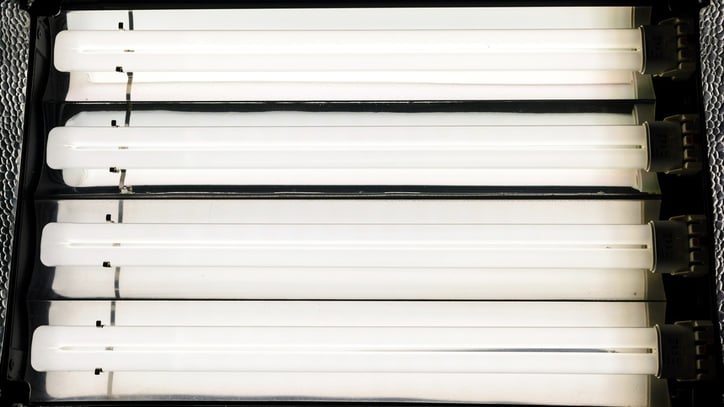What is fluorescent lighting?

Fluorescent lighting. You probably already have an idea of what it is. Maybe you even understand a little about how it works.
Sure, fluorescent lighting is known for hurting your eyes and washing out your complexion.
But there's a lot more to fluorescent lighting than the not-so-ideal side effects, including some nice benefits.
Here's what we're discussing in this post:
- How fluorescent lights work
- Why fluorescent lights need a ballast
- Where to use linear fluorescent tubes
- Pros and cons of linear fluorescent tubes
What is fluorescent lighting?
Fluorescent lighting is a highly versatile type of lighting that you most likely encounter at the office, school, or grocery store. It's known for energy efficiency compared to incandescent and halogen light bulbs, and a lower price compared to LEDs.
There are several different types of fluorescent lighting including linear fluorescent tubes, fluorescent bent tubes, fluorescent circline tubes, and CFLs (compact fluorescent lamps).
We're focusing on linear fluorescent tubes throughout this post because of their popularity. Fluorescent tubes are commonly used in overhead fixtures, like troffers, in all types of commercial buildings.

How do fluorescent lights work?
Fluorescent lighting depends on a chemical reaction inside of a glass tube to create light. This chemical reaction involves gases and mercury vapor interacting, which produces an invisible UV light. That invisible UV light illuminates the phosphor powder coating the inside of the glass tube, emitting white "fluorescent" light.
Here's a more detailed breakdown of the process:
Electricity first enters the light fixture, like a troffer, and through a ballast. The ballast – which regulates voltage, current, etc. and is necessary for a fluorescent bulb to light – feeds the electricity into the pins of the fluorescent bulb on both ends.
Read more: What is a ballast and how does it work?
Then, after the electricity enters through the pins, it flows to the electrodes inside the sealed glass tube, which is kept under low pressure. Electrons begin traveling across the tube, from one cathode to the other.
Inside of the glass tube are inert gasses and mercury which are excited by the electrical current. The mercury vaporizes as electricity flows, and the gasses begin reacting with each other to produce an invisible UV light that we actually cannot see with our naked eye.

But we obviously notice fluorescent light bulbs producing light, so what exactly are we seeing?
Every fluorescent tube is coated with phosphor powder. If you stuck your finger in the tube and rubbed the inside, it would look like you just enjoyed a powdered doughnut.
This phosphor coating glows when it is excited by the invisible UV light, and that is what we see with our eyes – glowing phosphor powder which creates a “white light.” That's where the term "fluorescent" comes from – “glowing white light.”
Because of the mercury that is contained in fluorescent lamps, it is important to recycle your lamps after they’ve burned out. We have a recycling service which makes it easy and quick to get the old burned out lamps out of your storage closet and off your mind. We also sell recycling boxes.
Why do fluorescent lights need a ballast?
The main purpose of a ballast is to take the alternating current coming through the wires in your walls – literally in waves, up and down – and turn it into a steady and direct stream of electricity. This stabilizes and maintains the chemical reaction that is occurring inside the bulb.
In order to choose the right ballast for your bulbs, you need to answer these three questions:
- What is the lamp type that needs power? (For example, is it a T8, T5? 4 foot? 2 foot?, etc.)
- How many lamps need power?
- What is the voltage going to the fixture?
Ballasts affect your energy usage through something called a ballast factor. Read more about ballast factor and how it affects energy usage here.
Why do fluorescent lights turn pink and orange?
If you look at a large room that's lit mostly by fluorescent tubes, there's a pretty good chance that you'll see all kinds of different colors coming from the ceiling. Why?
This concept is called “color shifting.” The longer fluorescents burn, the more likely it is that the chemical properties will shift and cause an imbalanced reaction, making the fluorescence less white and less bright than it once was.
If consistency is really important to your lighting project, you may want to look into group re-lamping these bulbs. By replacing all of the tubes in batches, you can will eliminate the issue of inconsistent colors and brightness in your space.
Another consideration is an LED upgrade for your tubes. We talk about the options for T8 LED tubes in this article.
What's the difference between linear fluorescent and compact fluorescent?
To clarify, both linear and compact fluorescent bulbs use the same technology to produce artificial light. The biggest difference is the form factor — or size and configuration — of the CFL tubes.
Compact fluorescent lamps (CFLs) are simply an enhancement to the linear fluorescent technology, using less energy. They are also designed to screw into a regular incandescent socket or plug into a recessed can. These are often referred to as "spring lamps" or "plug-in" CFLs depending on the use and shape
Learn more about compact fluorescents in our post, 'What are CFL bulbs and where should they be used?'
Where do you use linear fluorescent lighting?
While fluorescent light bulbs are used in a wide variety of applications, they don't work well everywhere. The most common reason people use fluorescent bulbs is to save energy with minimal up-front cost.
Here are some typical applications for linear fluorescent lighting:
Commercial offices
Typically, office spaces are not too concerned with decorative and accent lighting. The main priority is general lighting that is functional for the office environment. Because of this, linear fluorescents are the main bulb used in office spaces in the US.
Warehouses
If you’re not familiar with the high-output T5s, you need to be. These bulbs can last up to 90,000 hours and produce more light (lumens) than thicker linear fluorescent tubes such as T12s and T8s. Because of this, they are a great choice for warehouses — or really, any high-bay ceiling where a significant amount of light is needed.
Hospitals
Similar to office spaces, hospitals also use linear fluorescents to save money on energy and to produce a white, clean, efficient source of light.
Retail stores
When creating a unique lighting design for retail, we recommend the 20/80 rule – 20 percent of your lighting should be decorative and unique (think wall sconces, chandeliers, cloud bowls). And 80 percent of it should be standard general lighting.
In department stores such as Macy’s, JC Penney, Kohl's, and Target, the 80 percent general lighting is prime territory for linear fluorescents.
Linear fluorescent lighting pros and cons
Linear fluorescent pros
- Energy efficiency
By retrofitting from incandescent or halogen to linear fluorescent lighting, you can expect to see a 40 percent savings on your energy bill. - Variety of color temperatures
If you need a really “cool temperature” space, such as a hospital hallway or a Metro station, fluorescents offer color temperatures as cool as 6500 Kelvin. While there aren't many applications that require light quite that cool, the range of colors from warm to cool is a point of flexibility for fluorescents. - Cost
When compared to LED, linear fluorescent lighting tends to be more affordable. LED, in fact, has driven down pricing on fluorescents over the last several years.
Linear fluorescent cons
- Color shifting or lumen depreciation
As we mentioned above, the longer fluorescents burn, the more likely it is that the chemical properties will shift to cause an imbalanced reaction, making the fluorescence less white and less bright than it once was. Light output depreciates and your lighting can look like patchwork over time. - Harsh light
Fluorescents aren’t easy on the eyes! If you find your eyes are often bloodshot or dry, you may want to evaluate the light source you are under for most of the day. For example, linear fluorescent tubes in parabolic troffers in an office space can cause you to subconsciously squint due to the harsh light. A better application would be linear fluorescents in a center basket troffer, which softens the light that reaches the ground. - Warm up period
In order for the fluorescents to reach their full brightness, you may have to wait anywhere between 10-30 seconds for warm up. - Environmental impact or recycling cost
Although the recycling cost is outweighed by the energy savings fluorescents create, there is the added expense to make sure the fluorescent bulbs are properly disposed of. If you would rather not deal with the mercury and recycling at all, LED may be a better option for you.
Have more questions about whether fluorescent lighting is right for your application? Talk with a lighting expert who can speak to the specifics of your space.
















